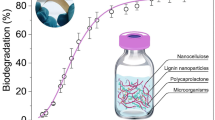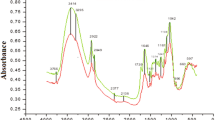Abstract
Oceans and soils have been contaminated with traditional plastic due to its lack of degradability. Therefore, green biopolymer composites reinforced with cellulose nanocrystal-zinc oxide hybrids (ZnO hybrids) with good biodegradation ability provided a positive impact on reducing environmental challenges. In this work, the effect of various morphologies of ZnO hybrids on the biodegradation ability of poly(butylene adipate-co-terephthalate), PBAT) under seawater, soil burial, and UV aging conditions were investigated. Sheet-like ZnO hybrids (s-ZnO hybrid) efficiently enhanced the mechanical, UV-blocking properties and biodegradation ability of PBAT nanocomposite films. Compared to neat PBAT, the best tensile strength of PBAT nanocomposite with 2 wt% s-ZnO hybrid was increased by 15.1%, meanwhile this nanocomposite films showed the highest biodegradation rate after 80 days of soil degradation and 90 days of seawater degradation. Besides, three possible biodegradation mechanisms of green PBAT nanocomposite films were presented, hinting that such PBAT nanocomposite have great promising packaging applications.
Graphic abstract








Similar content being viewed by others
References
Abdalkarim SYH, Yu H-Y, Wang C et al (2018) Sheet-like cellulose nanocrystal-ZnO nanohybrids as multifunctional reinforcing agents in biopolyester composite nanofibers with ultrahigh UV-shielding and antibacterial performances. ACS Appl Bio Mater 1:714–727. https://doi.org/10.1021/acsabm.8b00188
Al-Itry R, Lamnawar K, Maazouz A (2012) Improvement of thermal stability, rheological and mechanical properties of PLA, PBAT and their blends by reactive extrusion with functionalized epoxy. Polym Degrad Stab 97:1898–1914. https://doi.org/10.1016/j.polymdegradstab.2012.06.028
Arputharaj A, Nadanathangam V, Shukla SR (2017) A simple and efficient protocol to develop durable multifunctional property to cellulosic materials using in situ generated nano-ZnO. Cellulose 24:3399–3410. https://doi.org/10.1007/s10570-017-1335-5
Cai Y, Lv J, Feng J (2013) Spectral characterization of four kinds of biodegradable plastics: poly (lactic acid), poly (butylenes adipate-Co-terephthalate), poly (hydroxybutyrate-co-hydroxyvalerate) and poly (butylenes succinate) with FTIR and raman spectroscopy. J Polym Environ 21:108–114. https://doi.org/10.1007/s10924-012-0534-2
Diez-Pascual AM, Diez-Vicente AL (2014) ZnO-reinforced poly(3-hydroxybutyrate-co-3-hydroxyvalerate) bionanocomposites with antimicrobial function for food packaging. ACS Appl Mater Interfaces 6:9822–9834. https://doi.org/10.1021/am502261e
Geyer R, Jambeck JR, Law KL (2017) Production, use, and fate of all plastics ever made. Sci Adv. https://doi.org/10.1126/sciadv.1700782
Guan Y, Yu HY, Abdalkarim SYH et al (2019) Green one-step synthesis of ZnO/cellulose nanocrystal hybrids with modulated morphologies and superfast absorption of cationic dyes. Int J Biol Macromol 132:51–62. https://doi.org/10.1016/j.ijbiomac.2019.03.104
Haider TP, Völker C, Kramm J et al (2019) Plastics of the future? The impact of biodegradable polymers on the environment and on society. Angew Chemie Int Ed 58:50–62. https://doi.org/10.1002/anie.201805766
Han Y, Shi J, Mao L et al (2020) Improvement of compatibility and mechanical performances of PLA/PBAT composites with epoxidized soybean oil as compatibilizer. Ind Eng Chem Res 59:21779–21790. https://doi.org/10.1021/acs.iecr.0c04285
John A, Ko HU, Kim DG, Kim J (2011) Preparation of cellulose-ZnO hybrid films by a wet chemical method and their characterization. Cellulose 18:675–680. https://doi.org/10.1007/s10570-011-9523-1
Khan MZ, Militky J, Baheti V et al (2020) Growth of ZnO nanorods on cotton fabrics via microwave hydrothermal method: effect of size and shape of nanorods on superhydrophobic and UV-blocking properties. Cellulose 27:10519–10539. https://doi.org/10.1007/s10570-020-03495-x
Kijchavengkul T, Auras R, Rubino M et al (2011) Formulation selection of aliphatic- aromatic biodegradable polyester film exposed to UV/solar radiation. Polym Degrad Stab 96:1919–1926. https://doi.org/10.1016/j.polymdegradstab.2011.07.001
Kumagai S, Yamamoto M, Takahashi Y et al (2019) Impact of common plastics on cellulose pyrolysis. Energy Fuels 33:6837–6841. https://doi.org/10.1021/acs.energyfuels.9b01376
Lai L, Wang S, Li J et al (2020) Stiffening, strengthening, and toughening of biodegradable poly(butylene adipate-co-terephthalate) with a low nanoinclusion usage. Carbohydr Polym 247:116687. https://doi.org/10.1016/j.carbpol.2020.116687
Laycock B, Nikolić M, Colwell JM et al (2017) Lifetime prediction of biodegradable polymers. Prog Polym Sci 71:144–189. https://doi.org/10.1016/j.progpolymsci.2017.02.004
Li F, Abdalkarim SYH, Yu H-Y et al (2020a) Bifunctional reinforcement of green biopolymer packaging nanocomposites with natural cellulose nanocrystal-rosin hybrids. ACS Appl Bio Mater 3:1944–1954. https://doi.org/10.1021/acsabm.9b01100
Li H, Zhang L, Lu H et al (2020b) Macro-/nanoporous Al-doped ZnO/cellulose composites based on tunable cellulose fiber sizes for enhancing photocatalytic properties. Carbohydr Polym 250:116873. https://doi.org/10.1016/j.carbpol.2020.116873
Lizundia E, Ruiz-Rubio L, Vilas JL, León LM (2016) Towards the development of eco-friendly disposable polymers: ZnO-initiated thermal and hydrolytic degradation in poly(l-lactide)/ZnO nanocomposites. RSC Adv 6:15660–15669. https://doi.org/10.1039/c5ra24604k
Masson F, Decker C, Andre S, Andrieu X (2004) UV-curable formulations for UV-transparent optical fiber coatings. Prog Org Coat 49:1–12. https://doi.org/10.1016/s0300-9440(03)00122-x
Mohammadi M, Bruel C, Heuzey MC, Carreau PJ (2020) CNC dispersion in PLA and PBAT using two solvents: morphological and rheological properties. Cellulose 27:9877–9892. https://doi.org/10.1007/s10570-020-03460-8
Mohanty AK, Misra M, Hinrichsen G (2000) Biofibres, biodegradable polymers and biocomposites: an overview. Macromol Mater Eng 276–277:1–24. https://doi.org/10.1002/(SICI)1439-2054(20000301)276:1%3c1::AID-MAME1%3e3.0.CO;2-W
Mohanty S, Nayak SK (2012) Biodegradable nanocomposites of poly(butylene adipate-co-terephthalate) (PBAT) and organically modified layered silicates. J Polym Environ 20:195–207. https://doi.org/10.1007/s10924-011-0408-z
Moustafa H, Guizani C, Dupont C et al (2017) Utilization of torrefied coffee grounds as reinforcing agent to produce high-quality biodegradable PBAT composites for food packaging applications. ACS Sustain Chem Eng 5:1906–1916. https://doi.org/10.1021/acssuschemeng.6b02633
Pinheiro IF, Ferreira FV, Souza DHS et al (2017) Mechanical, rheological and degradation properties of PBAT nanocomposites reinforced by functionalized cellulose nanocrystals. Eur Polym J 97:356–365. https://doi.org/10.1016/j.eurpolymj.2017.10.026
Rajagopalan N, Khanna A (2013) Effect of size and morphology on UV-blocking property of nanoZnO in epoxy coating. Int J Sci Res Publ 3:1–14
Sai Prasanna N, Mitra J (2020) Isolation and characterization of cellulose nanocrystals from Cucumis sativus peels. Carbohydr Polym 247:116706. https://doi.org/10.1016/j.carbpol.2020.116706
Someya Y, Kondo N, Shibata M (2007) Biodegradation of poly (butylene adipate-co-butylene terephthalate)/layered-silicate nanocomposites. J Appl Polym Sci 106:730–736. https://doi.org/10.1002/app.24174
Tavares LB, Ito NM, Salvadori MC et al (2018) PBAT/kraft lignin blend in flexible laminated food packaging: peeling resistance and thermal degradability. Polym Test 67:169–176. https://doi.org/10.1016/j.polymertesting.2018.03.004
Venkatesan R, Rajeswari N (2017) ZnO/PBAT nanocomposite films: investigation on the mechanical and biological activity for food packaging. Polym Adv Technol 28:20–27. https://doi.org/10.1002/pat.3847
Venkatesan R, Rajeswari N, Tamilselvi A (2018) Antimicrobial, mechanical, barrier, and thermal properties of bio-based poly (butylene adipate-co-terephthalate) (PBAT)/Ag2O nanocomposite films for packaging application. Polym Adv Technol 29:61–68. https://doi.org/10.1002/pat.4089
Wang J, Wang L, Gardner DJ et al (2021) Towards a cellulose-based society: opportunities and challenges. Cellulose. https://doi.org/10.1007/s10570-021-03771-
Wang YY, Yu HY, Yang L et al (2019) Enhancing long-term biodegradability and UV-shielding performances of transparent polylactic acid nanocomposite films by adding cellulose nanocrystal-zinc oxide hybrids. Int J Biol Macromol 141:893–905. https://doi.org/10.1016/j.ijbiomac.2019.09.062
Xing Q, Buono P, Ruch D et al (2019) Biodegradable UV-blocking films through core-shell lignin–melanin nanoparticles in poly(butylene adipate-co-terephthalate). ACS Sustain Chem Eng 7:4147–4157. https://doi.org/10.1021/acssuschemeng.8b05755
Xu H, Feng Z-X, Xie L, Hakkarainen M (2016) Graphene oxide-driven design of strong and flexible biopolymer barrier films: from smart crystallization control to affordable engineering. ACS Sustain Chem Eng 4:334–349. https://doi.org/10.1021/acssuschemeng.5b01273
Ye S, Xiang X, Wang S et al (2020) Nonisocyanate CO2-based poly(ester- co-urethane)s with tunable performances: a potential alternative to improve the biodegradability of PBAT. ACS Sustain Chem Eng 8:1923–1932. https://doi.org/10.1021/acssuschemeng.9b06294
Yu HY, Zhang H, Song ML et al (2017) From cellulose nanospheres, nanorods to nanofibers: various aspect ratio induced nucleation/reinforcing effects on polylactic acid for robust-barrier food packaging. ACS Appl Mater Interfaces 9:43920–43938. https://doi.org/10.1021/acsami.7b09102
Zhu S, Chen Y, Tang Y et al (2019) A novel nanosilica-supported ultraviolet absorber for the preparation of robust biodegradable plastic film with high ultraviolet aging resistance. Polym Compos 40:4154–4161. https://doi.org/10.1002/pc.25276
Zumstein MT, Schintlmeister A, Nelson TF et al (2018) Biodegradation of synthetic polymers in soils: Tracking carbon into CO2 and microbial biomass. Sci Adv 4:eaas9024. https://doi.org/10.1126/sciadv.aas9024
Acknowledgments
The work was supported by Zhejiang Provincial Natural Science key Foundation of China (LZ20E030003), the Fundamental Research Funds of Zhejiang Sci-Tech University (2019Q001) and the Young Elite Scientists Sponsorship Program by CAST (2018QNRC001).
Funding
The authors declare no competing financial interest.
Author information
Authors and Affiliations
Contributions
GL: Conceptualization, Data curation, Investigation, Writing-original draft, Writing-review and editing. JZ: Project administration, Writing-review and Software. HY: Methodology, Writing-review and editing, Supervision. MJ: Investigation, Project administration. SYHA: Conceptualization, Writing—review and editing. YW: Investigation, Supervision.
Corresponding author
Ethics declarations
Conflict of interest
All authors declare that they have no conflict of interest.
Human and animal rights
This manuscript does not contain any studies with human participants or animals performed by any of the authors.
Additional information
Publisher's Note
Springer Nature remains neutral with regard to jurisdictional claims in published maps and institutional affiliations.
Supplementary Information
Below is the link to the electronic supplementary material.
Rights and permissions
About this article
Cite this article
Lu, G., Zhu, J., Yu, H. et al. Degradation mechanism of green biopolyester nanocomposites with various cellulose nanocrystal based nanohybrids. Cellulose 28, 7735–7748 (2021). https://doi.org/10.1007/s10570-021-04031-1
Received:
Accepted:
Published:
Issue Date:
DOI: https://doi.org/10.1007/s10570-021-04031-1




